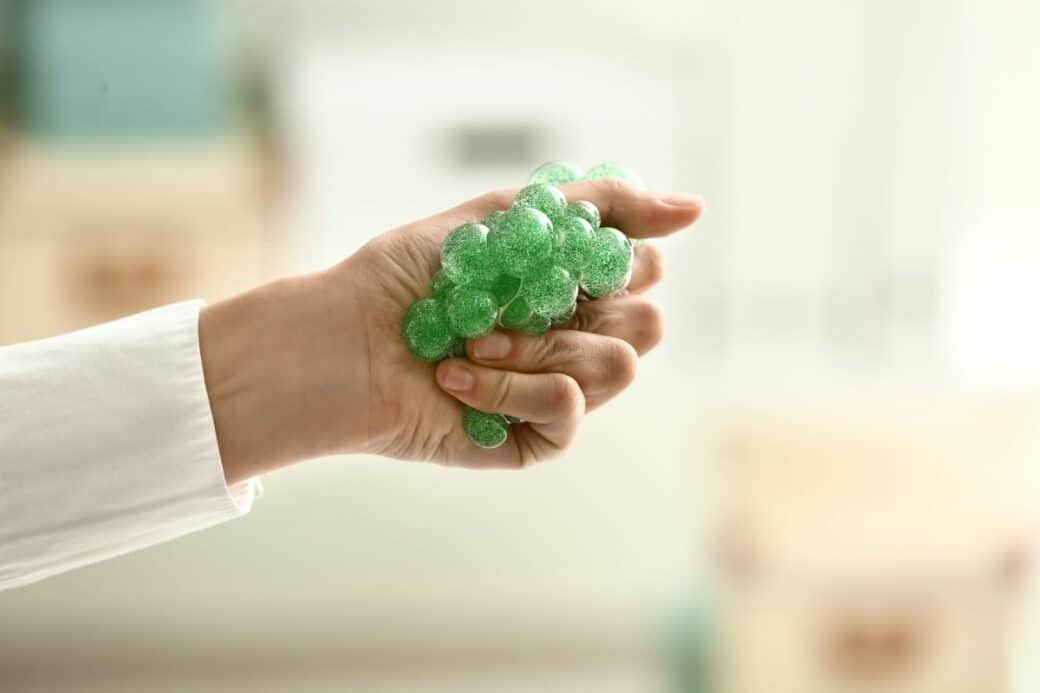Are you suffering from neuropathy and looking for ways to manage the pain? In this article, we explore the potential benefits of stress balls in helping alleviate the discomfort caused by neuropathy. Neuropathy can be a debilitating condition, resulting in nerve damage and chronic pain. While stress balls are commonly associated with stress relief, their potential effectiveness in managing neuropathic pain is worth considering. Let’s delve into the world of stress balls and discover if they can offer some relief for those enduring the challenges of neuropathy.

Do Stress Balls Help Neuropathy: Understanding Neuropathy
What is Neuropathy
Neuropathy, also known as peripheral neuropathy, is a condition that affects the peripheral nervous system, which includes the nerves outside the brain and spinal cord. It is characterized by damage or dysfunction in these nerves, leading to various symptoms. The condition can be caused by a wide range of factors, such as diabetes, infections, trauma, certain medications, and even genetic disorders.
What causes Neuropathy
Neuropathy can be caused by a variety of underlying factors. One of the most common causes is diabetes, where high blood sugar levels can damage the nerves over time. Other medical conditions, such as kidney disease, liver disease, and autoimmune disorders, can also contribute to the development of neuropathy. Additionally, certain medications, including chemotherapy drugs, can have a side effect of nerve damage. Overall, there are numerous potential causes of neuropathy, and proper diagnosis is crucial to determine the underlying cause and appropriate treatment.
Symptoms of Neuropathy
Neuropathy can manifest through a range of symptoms, which can vary depending on the specific nerves affected. Common symptoms include tingling or numbness in the hands or feet, a burning sensation, sharp or shooting pain, muscle weakness, and difficulty coordinating movements. Some individuals may also experience heightened sensitivity to touch or temperature changes, while others may have decreased sensation, making it difficult to feel things properly. As neuropathy can affect different nerves, symptoms can vary, and it is important to consult with a healthcare professional for an accurate diagnosis.
What is Stress Management
Definition of stress management
Stress management refers to the process of recognizing and coping with stressors in order to reduce negative effects on both physical and mental well-being. It involves adopting strategies and techniques to effectively manage and minimize stress, which can impact various aspects of life. By implementing stress management techniques, individuals can better handle stress, improve overall health, and enhance their ability to handle challenging situations.
Why it is important
Stress is a natural response to challenging situations, but when it becomes chronic or overwhelming, it can lead to negative health consequences. Chronic stress has been linked to a range of ailments, including cardiovascular disease, weakened immune systems, and mental health disorders such as anxiety and depression. Therefore, stress management is crucial to mitigate these risks and promote a healthier lifestyle. By effectively managing stress, individuals can improve their quality of life, enhance their well-being, and prevent potential complications.
Methods of managing stress
There are various methods and techniques for managing stress, and different strategies may work better for different individuals. Some common approaches include practicing relaxation techniques like deep breathing exercises, meditation, and yoga. Regular exercise, maintaining a balanced diet, and getting enough sleep are also important in managing stress. Additionally, engaging in enjoyable hobbies, spending time with loved ones, and seeking support from professionals or support groups can aid in stress management. It is essential to find what works best for you and incorporate these techniques into your daily routine for optimal stress reduction.
The Concept of Stress Balls
What is a stress ball?
A stress ball is a small, ball-shaped object designed to be squeezed and manipulated in the hand. It is typically made of a soft and pliable material, such as foam or gel, which provides a satisfying tactile experience. Stress balls come in various shapes, sizes, and textures, allowing individuals to choose one that fits their preferences.
How does a stress ball work
Using a stress ball involves repeatedly squeezing and releasing it in the hand. The rhythmic action of squeezing the ball activates the muscles in the hand and forearm, increasing blood flow and stimulating nerves. This can help relieve tension and reduce muscle stiffness, promoting a sense of relaxation and stress relief.
The psychology behind stress balls
The use of stress balls is based on the concept of sensory feedback and redirecting attention. The act of squeezing a stress ball provides a tactile sensation that can help divert attention away from stress or anxiety-inducing thoughts. This redirection of focus, combined with the physical engagement of muscles, may help individuals feel a sense of relief and relaxation. The repetitive action of using a stress ball can serve as a form of stress release, similar to how individuals may find comfort in activities like knitting or coloring.
Stress Balls and Neuropathy

Possible benefits of using stress balls for neuropathy
Using stress balls for neuropathy may offer several potential benefits. The repetitive squeezing and releasing motion can help improve blood circulation in the hands and feet, which is beneficial for individuals experiencing neuropathy symptoms. It may also help stimulate the nerves in the affected areas and promote sensory and motor function. Additionally, the tactile sensation provided by stress balls can offer a distraction from neuropathic pain, providing temporary relief and promoting an overall sense of relaxation.
Scientific research on stress balls and neuropathy
While there is limited scientific research specifically examining the use of stress balls for neuropathy, studies have explored the benefits of similar hand exercises for peripheral neuropathy. For example, some research suggests that hand exercises, including squeezing objects or using therapy putty, can improve grip strength and reduce symptoms in individuals with neuropathy. Although these studies do not specifically focus on stress balls, they provide insights into the potential benefits of hand exercises for neuropathy management.
Patient experiences
Many individuals with neuropathy have reported positive experiences with using stress balls as part of their management routine. They highlight the relief and distraction the ball provides, helping alleviate some of the discomfort associated with neuropathy. Some patients have also noticed improvements in their grip strength and dexterity over time, which can be particularly beneficial for performing daily tasks. While personal experiences can vary, these anecdotal accounts suggest that stress balls may have a place in managing neuropathy symptoms.
How to Use Stress Balls for Neuropathy
Correct technique of using stress balls
To properly utilize stress balls for neuropathy, it is important to follow correct techniques. Start by firmly gripping the stress ball in your hand. Squeeze the ball as hard as you can comfortably manage, holding it for a few seconds, and then release the pressure. Repeat this squeezing and releasing motion for a set duration or until you feel relief. It is crucial to maintain proper form and not overexert yourself, as this can lead to strain or injury.
Frequency and duration of stress ball exercises
The frequency and duration of stress ball exercises may vary depending on individual needs and preferences. It is generally recommended to start slowly and gradually increase the duration and intensity of the exercises. Begin with short sessions of a few minutes and gradually work your way up to longer durations as tolerated. As a guideline, aim for at least three to four sessions per day. However, it is important to listen to your body and adjust the frequency and duration based on your comfort level and any guidance provided by your healthcare professional.
Considerations or precautions
While stress balls can be a helpful tool in managing neuropathy symptoms, it is essential to consider certain precautions. If you experience any pain or discomfort during or after using the stress ball, it is advisable to consult with a healthcare professional. Additionally, those with pre-existing conditions such as arthritis or joint problems should exercise caution and modify their grip or the intensity of the exercises as needed. It is always important to prioritize safety and consult with a healthcare professional for personalized advice.
Alternative Treatments for Neuropathy
Medication options
Medical treatments for neuropathy may include the use of medications to manage symptoms and address underlying causes. Depending on the specific neuropathy type and severity, healthcare professionals may prescribe pain medications, such as analgesics or anti-inflammatories, to help alleviate discomfort. Other medications, such as antidepressants or anticonvulsants, can also be utilized to target nerve pain. It is essential to work closely with a healthcare professional to determine the most appropriate medication options based on individual needs and considerations.
Physical therapy
Physical therapy can play a crucial role in managing neuropathy symptoms. Therapists can design personalized exercise programs to target specific muscle weaknesses, improve balance, and promote flexibility. Additionally, physical therapy may include techniques such as electrical nerve stimulation or ultrasound therapy, which can aid in pain management. Physical therapists can guide individuals through exercises and techniques that can enhance mobility, reduce pain, and contribute to an improved quality of life.
Alternative holistic treatments
Many individuals with neuropathy turn to alternative holistic treatments to complement conventional methods. These may include acupuncture, massage therapy, chiropractic care, and herbal supplements. While the scientific evidence supporting these treatments is limited, some individuals report subjective improvements in their symptoms. It is important to approach alternative treatments with caution, seeking professional advice and informing healthcare providers of any treatments being pursued.
The Importance of a Holistic Approach
Combining stress balls with other treatments
Taking a holistic approach to neuropathy management involves considering multiple strategies and treatments to address different aspects of the condition. Stress ball exercises can be a valuable addition to a comprehensive treatment plan, alongside other interventions such as medication, physical therapy, and lifestyle modifications. By integrating stress ball exercises, individuals can benefit from the tactile and relaxation aspects while simultaneously pursuing other avenues of managing their symptoms.
Lifestyle changes to manage Neuropathy
In addition to medical treatments, certain lifestyle changes can significantly impact neuropathy management. Managing weight, maintaining a healthy diet, and controlling blood sugar levels in cases of diabetic neuropathy can help slow down the progression of the condition. Quitting smoking and reducing alcohol consumption are also advisable, as they can exacerbate neuropathic symptoms. Regular exercise and physical activity can improve blood flow to the extremities and help alleviate some symptoms. Implementing stress-management techniques, including the use of stress balls, can also contribute to a healthier lifestyle and better overall neuropathy management.
The role of mental health in managing Neuropathy
Neuropathy can take a toll on an individual’s mental health, leading to anxiety, depression, or decreased quality of life. It is crucial to address the emotional and psychological impact of living with neuropathy as part of a comprehensive management approach. Seeking support from mental health professionals or joining support groups can provide a valuable outlet for individuals to express their concerns, receive guidance, and gain a sense of community. By prioritizing mental well-being alongside physical management strategies, individuals can better navigate the challenges associated with neuropathy.
Pros and Cons of Stress Balls
Advantages of using stress balls
The use of stress balls offers several advantages for neuropathy management. They provide a portable and convenient tool for exercise, allowing individuals to perform stress-relieving movements wherever and whenever needed. Stress balls are relatively inexpensive and accessible, making them an affordable option for many individuals. They also have a low risk of side effects and can be used as a complementary therapy alongside other treatments without interfering with their effectiveness. Additionally, stress balls offer a simple and enjoyable way to target specific muscles and provide temporary relief from neuropathic discomfort.
Possible drawbacks or limitations of stress balls
While stress balls are generally safe and well-tolerated, there may be certain limitations or drawbacks. Some individuals may find it challenging to grip or squeeze the ball due to hand weakness or impaired dexterity, limiting their ability to fully benefit from stress ball exercises. Additionally, stress balls primarily target the hands and may not provide comprehensive relief for neuropathy symptoms affecting other body parts. It is important to recognize that stress balls alone may not be a sufficient solution for managing neuropathy and should be considered as part of a broader treatment approach.
Making an informed decision
When considering the use of stress balls for neuropathy management, it is crucial to make an informed decision based on individual needs and preferences. Consulting with a healthcare professional is highly recommended, as they can provide personalized advice tailored to your specific condition and circumstances. They can help determine whether stress balls are suitable for you, recommend any modifications or alternatives, and ensure that stress ball exercises are integrated into a comprehensive treatment plan.
Testimonials and Success Stories
Stories of people using stress balls for neuropathy
Numerous individuals living with neuropathy have shared their experiences with using stress balls as a part of their management strategies. These personal testimonials often highlight the relief and relaxation provided by stress balls, with many individuals reporting a reduction in neuropathic discomfort. They emphasize the ease of incorporating stress balls into daily routines and appreciate the tangible benefits they offer for improving hand strength and flexibility.
Quantifiable results and improvements
While quantifiable results may vary from person to person, some individuals have documented improvements in grip strength, reduced pain levels, and enhanced overall well-being as a result of using stress balls for neuropathy. These measurable outcomes, although subjective, reflect the potential benefits that stress balls can offer as part of a comprehensive management plan.
The Emotional and mental impact
Beyond physical improvements, stress balls can have a significant emotional and mental impact on individuals living with neuropathy. Many testimonials describe a sense of empowerment and control over their symptoms, as well as a reduction in anxiety and stress levels. The act of engaging with stress balls provides a positive outlet for managing emotions and serves as a form of self-care during challenging times.
Expert Opinions
What doctors say about stress balls and neuropathy
Healthcare professionals, including doctors, often advocate for a multi-faceted approach when it comes to managing neuropathy. While stress ball exercises are not typically the primary recommendation, many medical professionals acknowledge the potential benefits. They view stress balls as a valuable tool for engaging hand muscles, improving grip strength, and incorporating enjoyable activities into a neuropathy management routine.
Physiotherapists’ perspective
Physiotherapists play a critical role in treating individuals with neuropathy, and their perspective on stress balls is valuable. They view stress balls as a useful adjunct to therapeutic exercises, enabling patients to continue their rehabilitation at home. Physiotherapists often incorporate stress balls into hand therapy routines to strengthen hand muscles, improve dexterity, and provide a sense of achievement in patients with neuropathy.
Mental health professionals’ viewpoint
Mental health professionals recognize the importance of addressing the psychological impact of neuropathy and understand the potential benefits of stress balls. They acknowledge that stress ball exercises can promote relaxation, serve as a distraction from pain, and provide a sense of control over symptoms. Mental health professionals often recommend stress balls as a part of stress management strategies, highlighting their potential to support overall well-being in individuals with neuropathy.
In conclusion, managing neuropathy is a multifaceted endeavor that involves addressing various aspects of the condition. Stress balls can be a helpful tool in this process, providing a tangible and enjoyable way to engage hand muscles, promote relaxation, and distract from neuropathic discomfort. While stress balls alone may not be a complete solution, when combined with other treatments, lifestyle modifications, and a holistic approach, they can contribute to an improved quality of life for individuals living with neuropathy. It is important to consult with healthcare professionals, consider individual needs, and make informed decisions to ensure comprehensive and personalized neuropathy management.




